Nine Vietnamese heritage sites recognized by UNESCO as world natural and cultural heritage sites
Recently in Riyadh, the capital of Saudi Arabia, the 45th enlarged session of the World Heritage Committee of UNESCO has included the Halong Bay-Cat Ba Islands group in Quang Ninh Province and Haiphong City on the World Natural Heritage List. Up to now, nine heritage sites in Vietnam have been recognized by UNESCO as world natural and cultural heritage sites, including 5 cultural heritage sites, 3 natural heritage sites, and 1 mixed heritage site.
1. Hue Ancient Capital Ruins Group—World Cultural Heritage
.jpg)
In December 1993, Hue's ancient architectural complex was included in the World Cultural Heritage List. The Hue Ancient Building Group is composed of the historical culture built by the Nguyen Dynasty in Vietnam from the first half of the 19th century to the first half of the 20th century in the original capital of Hue.
Hue's ancient architectural complex is divided into two parts: inside the city and outside the city. The city includes the protective city, the imperial city and the Forbidden City as a whole. Just outside the city there are some masterpieces of monuments harmoniously harmonious with the natural location.
2. Halong Bay - World Natural Heritage

On December 17, 1994, Halong Bay was included in the World Natural Heritage List. On December 2, 2000, Halong Bay was once again recognized as a World Natural Heritage. The New Seven Wonders of the World Foundation announced on November 11, 2011 that Vietnam's Halong Bay was selected into the list of the "New Seven Natural Landscapes of the World".
Halong Bay is a small bay in the western part of the Tonkin Gulf in the northeastern waters of Vietnam. It includes islands that are part of Halong City, Cam Phuc City and Van Don District. Halong Bay has a total area of 1,553 square kilometers and a total of 1,960 large and small islands.
3. My Son Holy Land - World Cultural Heritage
.jpg)
In December 1999, My Son Holy Land was included in the World Cultural Heritage List. The My Son Holy Land in Quang Nam Province is located in a valley with a diameter of about 2 kilometers and consists of many ancient Cham pagodas. My Son is a collection of various artistic buildings left over from Cham Towers in central Vietnam. The most amazing thing about My Son is the tower-building technology, stone carving art and aesthetics of Cham artists. The My Son temple ruins have three major building complexes, which are very large in scale. Their construction and carving styles are very different from those in other parts of Vietnam.
4. Hoi An Ancient Town – World Cultural Heritage
.jpg)
In December 1999, Hoi An Ancient Town was included in the World Cultural Heritage List. Hoi An is located on the lower reaches of Thu Bon River in the coastal area of Quang Nam Province, about 30 kilometers away from Da Nang City.
In the 18th century, Hoi An was a busy port. Hoi An not only has nostalgic streets, but also blue beaches and quiet and fresh scenery. Hoi An’s natural landscape and cultural features are very attractive.
When traveling to Hoi An, tourists must try Vietnamese-style street food, such as pasta, chicken rice, bread, barbecue rice noodles, etc.
5. Fengya-Gebang-World Natural Heritage
.jpeg)
In July 2003, Phong Nha-Ke Bang National Park was officially included in the World Natural Heritage List. Phong Nha-Ke Bang National Park is located in Quang Binh Province in central Vietnam, with a total area of approximately 200,000 hectares. The park has become a famous tourist attraction in China and the world.
Phong Nha-Ke Bang National Park is home to the most beautiful river in Southeast Asia and a rich and diverse system of flora and fauna. The total length of the cave system here is about 80 kilometers.
6. Hanoi Thang Long Imperial Citadel - World Cultural Heritage
.jpg)
On July 30, 2010, Hanoi's Thang Long Imperial Citadel was included in the World Cultural Heritage List. Thang Long Imperial Citadel is located in Hanoi, the capital of Vietnam. For 1,000 consecutive years, Thang Long Imperial City has been a unique intersection of human culture, sculpture art, architectural art, construction technology, urban planning and landscaping art. In April 2022, the Thang Long Heritage Conservation Center launched a night tour of Thang Long Imperial City for domestic tourists, which was well received by tourists.
7. Hu Chaocheng - World Cultural Heritage

On June 27, 2011, Hu Chaocheng was included in the World Cultural Heritage List. Hu Chao City, built in 1397, is the only stone city wall building in Vietnam. This rectangular stone city is 900 meters long and 700 meters wide, with walls five to six meters high. The entire city wall is built with giant stones. The city wall and the four main gates are all made of square, flat blue stones, and the joints are tightly jointed and extremely solid.
8. Chang'an Relics Group - mixed cultural and natural heritage
(1).jpg)
In June 2014, the Trang An ruins group was included in the list of mixed cultural and natural heritage, becoming the first mixed cultural and natural heritage in Vietnam and even Southeast Asia.
The total area of Chang'an scenic spots exceeds 12,000 hectares. Among them, the Chang'an Scenic Spots Heritage Area has a total area of 6,226 hectares. Trang An scenic spot is a place where culture and nature thrive in harmony and is known as the "Halong Bay on land".
This group of scenic spots is composed of the ruins of the ancient capital of Hua and Fujian, the Chang'an-Three Coc-Bidong scenic area, and the Hua-Fujian special primeval forest. The Chang'an-Three Coc-Bidong scenic area has been recognized as a national heritage area. Chang'an scenic spots are increasingly becoming a popular tourist destination for tourists
9. Halong Bay-Cat Ba Islands-World Natural Heritage List

In September 2023, Halong Bay-Cat Ba Islands were included in the World Natural Heritage List. It has extremely beautiful natural scenery. Each island is covered with dense jungle vegetation, and limestone peaks tower above the horizon of the sea. It is a karst terrain formed by limestone dissolved by water. A network of mountains, forests and islands, the Halong-Cat Ba archipelago has Asia's highest diversity. There are seven ecosystems here, including the original tropical rainforest ecosystem, cave ecosystem, and mangrove ecosystem. (over)
From Vietnam News Agency

















